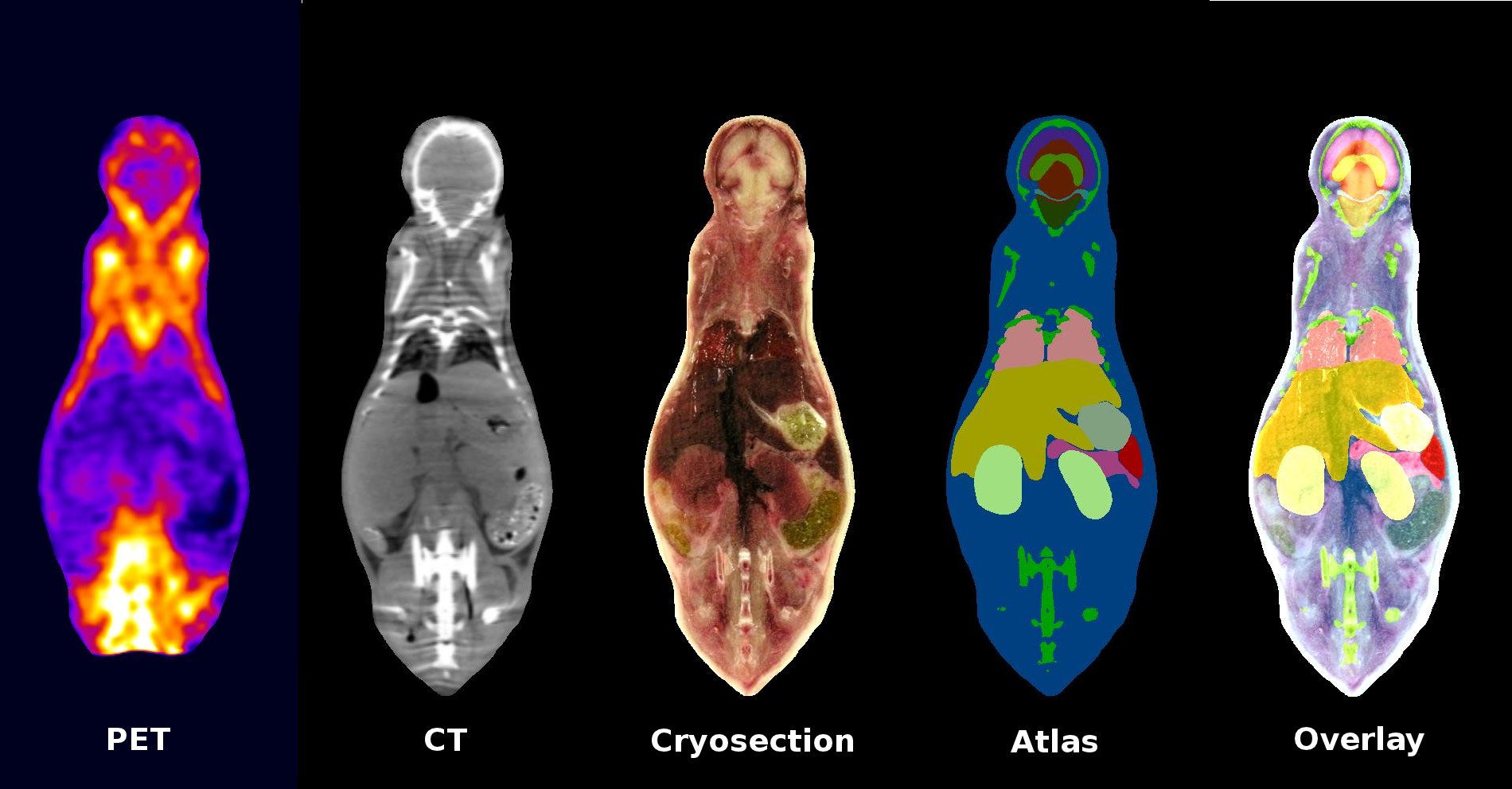Digimouse: Data alignment and resampling
Overview | Data Acquisition | Registration | Creation of Atlas | Simulations | Download | License
We constructed Digimouse on an isotropic 0.1mm grid from coregistered and resampled CT and cryostat data. Prior to constructing the Digimouse we resampled the cryosections and registered the CT data to the cryostat volume. We will now describe these steps in detail.
-- In the process of acquiring the cryosection pictures, minor shifts have occurred since the moving belt of the cryostat did not always reposition the mouse in exactly the same location with each pass under the cutting knife. These caused the movements in the bed of the mouse and hence the linear misalignments of these slices. These misalignments have occurred only on the plane of the bed so we just needed to find the translation in the axial and sagittal directions within slices for accurate registration. We segmented the fiducial markers in each slice and cross-correlated the fiducial markers in successive images to determine these misalignments within slices and registered the cryosection images accordingly. Later, we cropped the cryosection slices getting rid of the unnecessary background and resampled the slices using "bicubic interpolation" so that each cryosection slice has 0.1mm x 0.1mm voxel size. Since the slice thickness was 50um we took the every second slice to generate an isotropic 0.1mm cubical voxels with a matrix size of 380 x 992 x 208 cryosection volume.
-- We also cropped the CT Data to a manageable size of 372x920x292 and adjusted the contrast of the CT using the software ImageJ so that we can extract more information regarding the anatomy. We then registered the CT data to the cryostat data using RVIEW which uses mutual information for rigid transformation. After rigid registration, the overlay of the cryostat image and the CT image showed misalignments around the head region and limbs. During the packing and freezing process some of the structures like the ears, limbs and head shifted. Moreover since the mouse was only partially frozen to avoid fractures and thawed slightly during the process, changes in its shape occurred. Since the skeleton is a rigid structure which is not effected from nonrigid shape changes but only piecewise rigid changes, we segmented the skull in the CT image using thresholding and morphological processing and registered it rigidly to the cryostat head using RVIEW. We did the similar process to the bones in the limbs since they also shifted during the packing and freezing process. This step required a lot of careful inspection and manual work and the resultant skeleton was created by the combination of piecewise rigidly registered limbs, skull and the remaining skeleton. We also segmented the skin from CT data using thresholding and morphological processing and rigidly registered it to the cryostat data. Later, we manually edited the skin to compensate for the nonrigid deformations in the skin of the cryostat data after overlaying the rigidly registered skin onto the cryostat data. Since CT does not provide good definition of structures other than bones and soft tissue, we used the manually edited skin and the piecewise rigidly registered skeleton to estimate the general shape change between the CT and the cryostat data. We used LEREG (Linear Elastic Registration Software) to perform a consistent linear elastic deformation of the CT data to the cryostat data by finding the transformation between the skeleton+skin volume of the CT data to the semimanually registered skeleton+skin volume of the crystat data. The resultant deformation was then applied to the whole volume of the CT image. Because of time complexity, the nonrigid registration was performed on downsampled data which had the voxel size of 0.2mm.
-- The PET image had 0.4mm voxels in the planar section and 0.6mm in the axial direction with a matrix size of 128x127x128. We also adjusted the contrast of the PET data using software ImageJ. We then registered PET data to the CT data using RVIEW. The rigid registration was sufficient for accurate PET-CT registration. Since the PET image was perfectly registered to the CT data by rigid transformation we applied the same nonrigid transformation we obtained from CT to cryostat registration to the PET data using LEREG to transform the PET data into the coordinate frame of cryostat data.
RVIEW: Studholme, C., Hill, D. L. G., and Hawkes, D. (Jan 1999). An overlap invariant entropy measure of 3D medical image alignment. Pattern Recognition, 32(1):71-86.
LEREG: Christensen, G. E. (1999). Consistent linear-elastic transformations for image matching. Information Processing in Medical Imaging, LCNS 1613, Springer-Verlag, pp. 224–237.
Current configuration does not allow embedding of the file anim3.swf because of its mimetype application/x-shockwave-flash.: anim3.swf |
|
Final Registered PET, CT, Cryosection, Atlas images for a coronal slice

